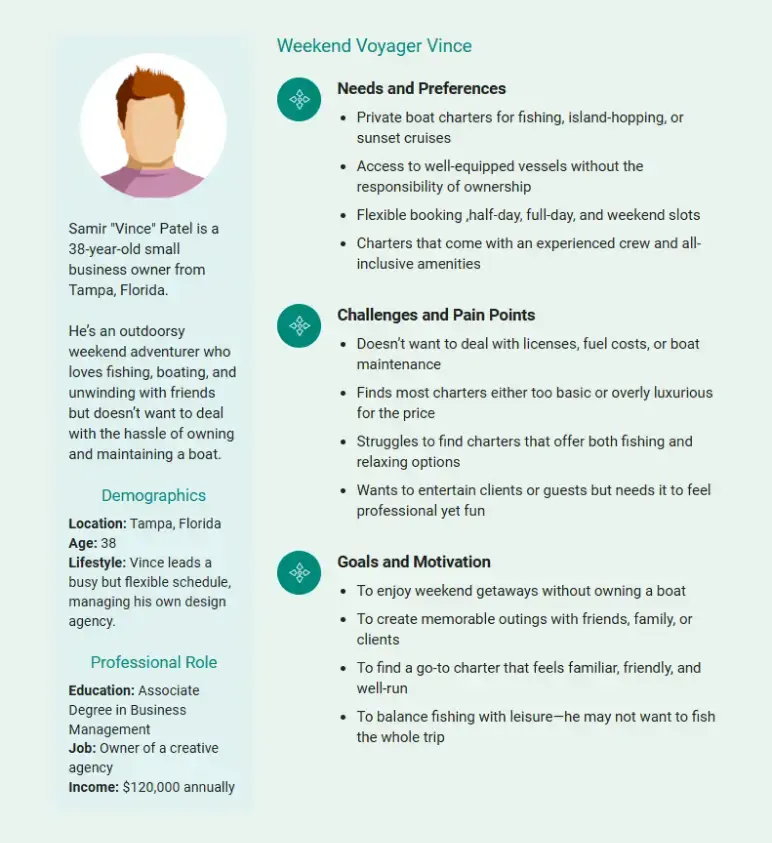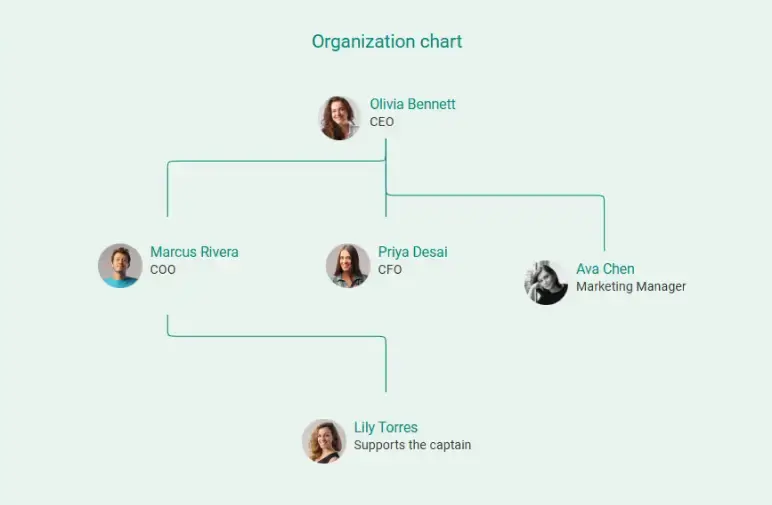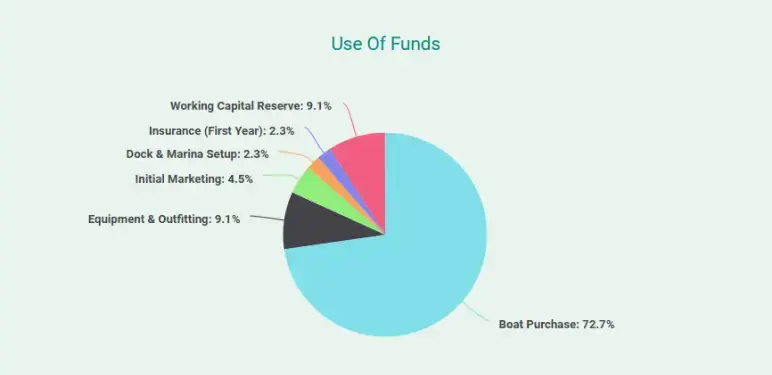Starting a charter boat business? It’s an exciting venture where you can turn your love for boating into a profitable enterprise.
But before you start offering fishing trips or luxury yacht charters, you need a solid business plan to chart your course. Without a solid business plan, you could end up adrift in a sea of expenses and unexpected challenges.
Wondering how to draft a plan?
This charter boat business plan template will walk you through every step to help you launch with confidence.
What is a charter boat business plan?
A charter boat business plan is a professional document that explains your services, target market, pricing, operations, and financial goals. It helps you organize your strategies, attract customers, and get funding.
Whether you run fishing trips or private yacht tours, the plan keeps your business focused and ready for growth.
Why do you need a yacht charter business plan?
Writing a business plan might feel like extra work when you’re excited to start your own yacht charter business, but it’s important for a few key reasons:
- Helps you clearly define what you offer, who you serve, and how you’ll price it
- Shows if your location, boat costs, and demand can actually turn a profit
- Required if you're applying for a loan or seeking investment
- Keeps you on track with clear goals and a budget
- Prepares you for slow months, repairs, or new competition
- Lets you spot problems early—before you waste money
In short, a plan gives your business structure and helps you make smart choices before you dive in.
How to write a successful charter boat business plan?
Creating a charter boat business plan may feel challenging at first, but breaking it into clear steps makes the process manageable.
Here are the key sections your plan should include, along with simple tips for writing each one:

1. Executive Summary
The executive summary is the opener for your charter boat business plan—a concise overview of your entire plan. Think of it as your 30-second elevator pitch that convinces the reader how your charter boat venture will succeed.
Even though it appears first, write this section last. Once you’ve hashed out details in other sections, you can distill the highlights in this section.
Here’s what to include in your executive summary:
- Business Introduction: Name, location, and the type of charters you offer.
- Market opportunity: Highlight a gap or demand in the market you're addressing and why now is a good time to launch.
- Services & USP: Summarize your main services and what makes them stand out, like expert crew, premium equipment, or unique experiences.
- Marketing & sales: Briefly mention how you'll attract new customers and retain existing ones.
- Financial snapshot: State how much funding you need (if any), your expected revenue, and when you plan to reach profitability.
By the end of the executive summary, anyone reading should grasp the essence of your charter boat business—the what, where, how, and why it will succeed.
Hence, keep this section clear and jargon-free, as it may be the only part some busy readers examine. If you hook them here, they’ll continue through the rest of the plan.
2. Company Description
The company description section gives more detail on who you are and why you exist. Consider it the story of your charter business’s identity, your mission, structure, and background.
Start with basic details like your business name, location, and legal structure. Are you operating as a sole proprietor, an LLC, or a corporation?
Next, describe the types of charter boats and services you’ll provide. There are many kinds of charters, so specify your niche. Introduce the founders or owners of the business. Briefly note relevant experience or passion.
Also, state your mission statement – a short, inspiring statement of your business’s purpose. Don’t forget to share your vision for the future: where you see the business in 5 or 10 years.
If your charter business is already operating or if you’ve run charters informally, include a brief history. If you’ve achieved early milestones, highlight them.
Lastly, outline your short-term and long-term goals. Setting concrete goals shows you have a growth mindset and a plan to scale or sustain the business.
3. Market Analysis
No business operates in a vacuum, especially not in tourism and recreation. The industry analysis section shows your understanding of the boating charter industry and target market.
You’ll want to show that you know who your customers are, what they want, how the market is trending, and who you’re competing against.
The following are the key elements to include in this section:
Target Market & Customer Profile
Describe your ideal customers—tourists, families, fishing enthusiasts, corporate groups, etc. You might have more than one segment.
Creating a simple buyer persona helps clarify what they’re looking for and how to serve them better. For instance:

Market Size and Trends
Dive deeper into trends that affect charter businesses. Is there a surge in demand for private experiences post-pandemic? Are people willing to pay more for charters that practice sustainable, eco-friendly operations? Mention regulatory trends, too.
Competitive Analysis
List direct competitors (other charter boats nearby) and indirect ones (like sailing rentals or whale-watching).
Explain what they do well, what they lack, and how you’ll stand out—maybe with better service, local knowledge, or unique offers like sunset dinner cruises.
Regulatory Environment
Shed light on the key licensing needs. This shows you understand and plan to meet these requirements while increasing trust.
4. Services Offered
In a charter boat business, the services you provide are the core of your offering.
This section explains exactly what you’re selling—charter services, customer experiences, and any related add-ons. Be clear and specific, as this section defines the core of your business.
To break it down clearly, start by outlining the different types of services you’ll offer and what each includes.
Core charter services
List the main types of packages you’ll offer: half-day fishing, full-day deep-sea charters, sunset cruises, island hopping, dolphin watching, or party yacht rentals. Describe each briefly.
Specialized activities
Mention any unique offerings like scuba diving, snorkeling, spearfishing, or photography tours. These add-ons justify premium pricing.
Equipment and amenities
List the gear and features provided by fishing rods, snorkeling sets, life vests, and boat amenities like a kitchenette, restroom, shaded deck, or Bluetooth sound system. Highlight quality and safety to reassure customers.
Additional services or products
Mention any extra services that add value or generate revenue. This might include branded items, trip photography, or services like fish cleaning or on-board catering.
Keep the focus on the customer experience, fun, relaxation, and adventure, not just the logistics.
5. Marketing Strategies
“Build it and they’ll come” doesn’t work in the charter world—you need a clear plan to get customers and turn interest into bookings. This section explains how you’ll promote your services, stand out, and convert interest into sales.
Start with what makes you different—whether it’s expert-guided eco tours, high-end gear, or unmatched local experience.
Explain where your pricing fits in the local market. Mention package tiers, group rates, seasonal promos, or loyalty offers (like every 5th trip, 50% off). Something like this:

Next, focus on the platforms that help reach your target audience:
- Website and booking platforms
- Social media
- Partnerships with hotels, B&Bs, and bait shops
- Reviews and referrals through word of mouth
Further, explain how customers book online, by phone, or by email, and how you follow up with confirmations and trip details. Keep it simple and responsive.
If applicable, include repeat-booking perks and referral bonuses. Make the experience memorable with a clean brand, great service, and moments worth sharing, like crew-taken photos or custom trip options.
6. Management Team
Investors and lenders often say they invest in people as much as in ideas. The management team section highlights who’s steering the ship and why they’re qualified to make this charter business a success.
Even if you’re a solo entrepreneur, you should detail your relevant experience and any advisors or key hires.
Start with the founders or owners. Provide a brief bio focusing on experience relevant to the charter or business management.
Next, describe any key team members or planned hires. If you operate multiple boats, you may need more captains. If someone regularly assists onboard, like a first mate or deckhand, include them too.
Include a short explanation of how your team is structured. In small operations, it’s often flat but organized. If you expect to expand, consider mentioning how the structure could evolve as more vessels and crew are added.
If required, illustrate a simple organizational chart here to visually show team structure and reporting lines. For instance:

You can also list any external advisors or consultants who support your business. These might be experienced captains, legal or financial advisors, or industry mentors.
By the end of this section, readers should feel confident that the business is in capable hands. They’ll understand who is responsible for what and why those people are suited for the job.
7. Operations Plan
The operations plan details the nuts and bolts of how your charter boat business will run on a daily basis. It covers everything from staffing and suppliers to the processes that keep your business afloat.
In this section, you’ll convince readers that you have a handle on the practical aspects of running charters safely and efficiently.
Here are several key areas to discuss in this section:
Facilities and Location
State where your boat operates from. Include your dock or marina slip, office (if any), and storage. If you use a trailerable boat, explain how you’ll launch from ramps. Highlight if your location is tourist-friendly, secure, or easy to access.
Staffing & Crew
Explain how your team is set up. Will you operate solo, or do you have a deckhand, guide, or tour assistant? Add any relevant training or certifications, like CPR or lifeguard experience.
Trip Workflow
Walk through a typical trip, step by step:
- Pre-trip: Send confirmations and check the weather, and boat readiness
- Start: Crew arrives 1 hour early for prep; guests arrive 15 minutes before departure for the safety briefing
- During: Follow the planned route and ensure safety and comfort
- Post-trip: Return, clean the boat, log the trip, and ask for reviews or repeat bookings
Suppliers and Partners
List any regular suppliers like fuel providers, bait shops, or snack vendors. If you’ve built relationships with other charters or local businesses for backup or referrals, mention them here.
Equipment & Maintenance
List your main vessel and the equipment you provide, like fishing gear, navigation tools, or safety kits. Mention how often you service the boat and check the equipment. Note any spare parts or backup plans in case of breakdowns.
Inventory & Downtime Plan
Note how you track inventory, such as life vests, rods, or first-aid supplies, and when you restock. If your business has a slow season, explain how you plan major maintenance or upgrades during that time.
Overall, the operations plan should instill confidence that you can deliver the services you promise in your plan.
It’s about showing you’re not just a dreamer with a boat, you’re a capable operator with a plan for the day-to-day details, from fueling up to handling customer inquiries.
8. Financial Projections
The financial plan is where you translate everything you’ve said into dollars and cents.
It demonstrates the viability of your charter boat business in financial terms, showing how you’ll make money, cover expenses, and ideally turn a profit over time. This section is critical, especially if you’re seeking funding.
The following are the key elements to include in your charter boat financial plan:
- Startup costs: List one-time expenses like boat purchase, outfitting, licenses, and initial marketing.
- Revenue projections: Estimate revenue over 3–5 years based on bookings and rates.
- Expense projections: Ongoing costs include fuel, maintenance, and dock fees, Insurance and crew wages, Marketing, admin, and permit renewals.
- Profit & loss forecast: Shows profit expectations based on revenue minus expenses.
- Cash flow: Explain how cash will flow, especially in the early months.
- Balance sheet projections: Outline your assets, liabilities, and equity.
- Financial assumptions: List key assumptions for transparency.
In short, the financial plan proves your charter boat business is viable and well thought out. Clear, realistic financial projections help build trust, whether you're funding it yourself or seeking investment. It shows you’re ready to manage costs, earn revenue, and stay financially stable.
9. Funding Request
If you’re seeking funding to start or expand your charter boat business, this section outlines exactly how much funding you need, what you’ll use it for, and how much you’re personally contributing.
It’s important to be specific and realistic—investors and lenders want to see a clear plan and that you’ve thought it through.
Start by stating the total amount you’re requesting. Here’s a sample funding allocation for clarity:

| Use of Funds | Amount (USD) |
|---|---|
| Boat Purchase | $80,000 |
| Equipment & Outfitting | $10,000 |
| Initial Marketing | $5,000 |
| Dock & Marina Setup | $2,500 |
| Insurance (First Year) | $2,500 |
| Working Capital Reserve | $10,000 |
| Total Funding Requested | $100,000 |
If applicable, mention what the lender or investor receives in return, such as a fixed interest rate (for a loan) or a share in the business (for equity investment).
Also, include your own contribution. If you’re putting in personal savings, highlight that. It shows commitment and gives confidence that you’re invested in the success of the business.
Be sure your numbers align with the financials in your projections section. This table should match the startup cost estimates and show that funds will be used responsibly across key areas.
Download a free charter boat business plan template
Ready to build your charter boat business plan but not sure where to begin? No worries! We’ve got you covered! Download our free charter boat business plan template in PDF to get started.
This investor-ready template has helped many new charter operators turn their ideas into real businesses. I hope it does the same for you. With clear examples and expert tips, it makes planning easier and helps you cover all the important details.
Get help writing your plan
After reading this comprehensive guide, you now have a better understanding of how to create a charter boat business plan.
But if you ever feel stuck or need expert advice, don’t hesitate to reach out to professional business plan consultants. They’ll help you polish your plan and ensure it’s ready to impress investors.
So, why wait? Start planning today!
Frequently Asked Questions
Why do I need a charter boat business plan?
A successful business plan gives you a clear direction. It helps you set goals, manage trips and bookings, and keep your finances in check. It also ensures you follow boating laws and get the required permits and licenses. If you're looking for funding, a solid plan shows investors and lenders that you have a clear strategy to grow and make money.
How can I get funding to start my charter boat business?
You can fund your charter boat business through several options:
- Personal savings
- Small business loans
- Government grants
- Private investors
- Crowdfunding platforms such as Kickstarter
- Business credit cards
- Equipment financing or leasing
What licenses or certifications do I need to run a charter boat?
You’ll likely need the following licenses or certifications to run a charter boat:
- A captain’s license
- Boat registration
- Commercial insurance
- Local regulations or permits for fishing and snorkeling
- Zoning approvals
Always check with your local harbor authority or city/county office to get the exact list.
How much does it cost to start and run a charter boat business?
The cost varies. If you do it yourself, it’s free—except for your time. But if you hire a business plan writer or consultant, the cost will vary from $1,000 to $5,000 or even more, depending on the type of charter boat business plan you need. And if your budget is pretty tight, you can simply use an online charter boat business plan template or example for creating your plan.
What is the easiest way to write and update my charter boat business plan?
One of the easiest ways to write and update your charter boat business plan is to start with a ready-made template. It gives you a clear structure and step-by-step guidance, which makes the writing process faster and more manageable. You can customize it later based on your market research, service offerings, and long-term business goals.

